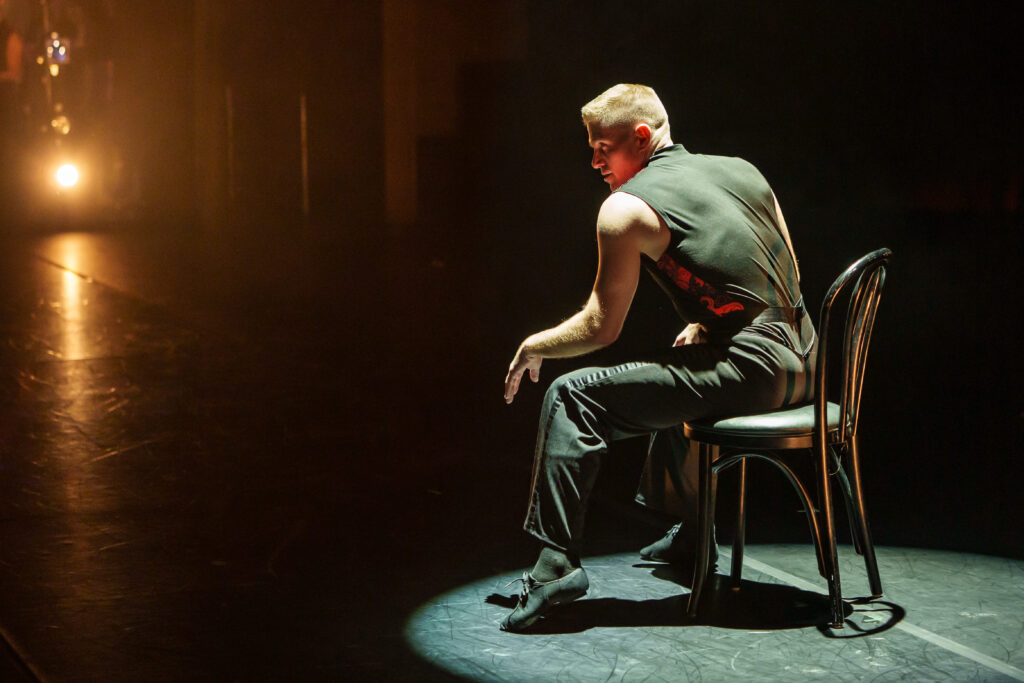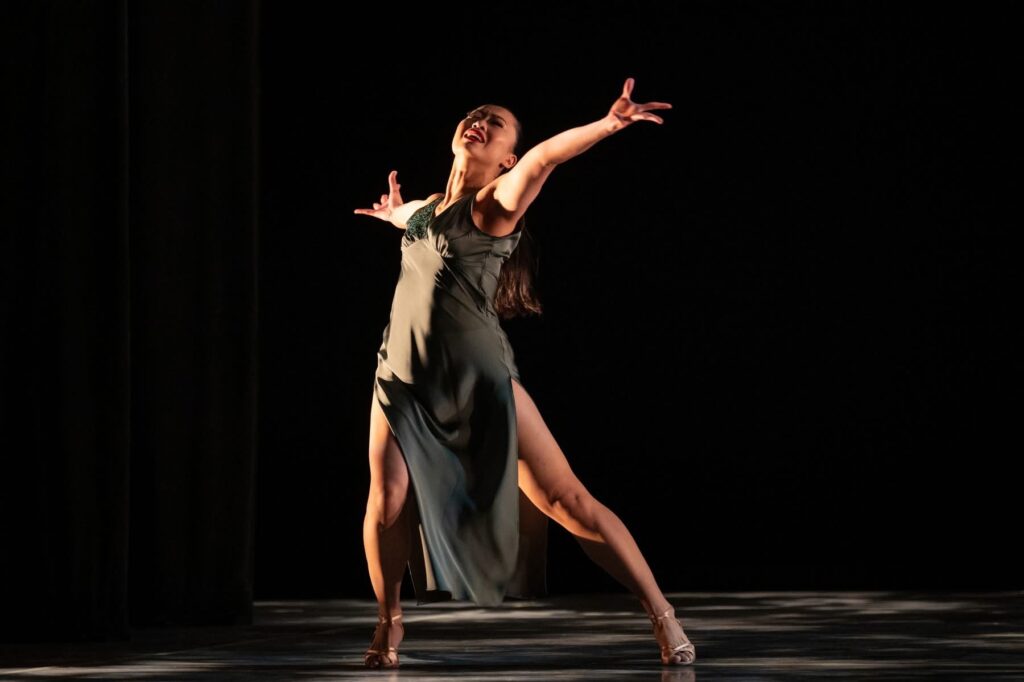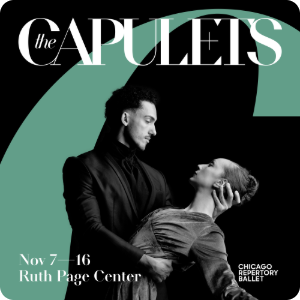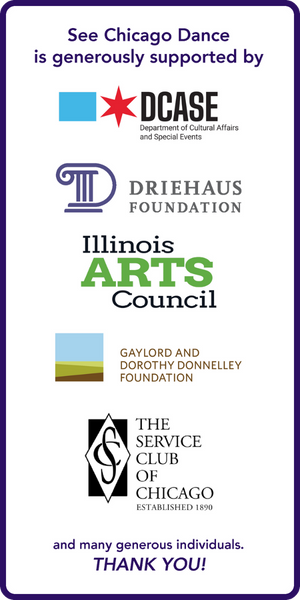October 23, 2025
By Lynn Colburn Shapiro
Giordano Dance Chicago’s knockout season opener, “Ignite the Soul,” brings to mind the famous passage from Ecclesiastes, 3:1: “To every thing there is a season, and a time to every purpose…” for birth and death, rejoicing and mourning, joy and sadness. The company’s fall repertoire reflects that sentiment on both personal and universal levels, with beautifully balanced and thought-provoking programming.

Gus Giordano’s iconic “Sing, Sing, Sing” (1983) opened the program in homage to Gus’s legacy to the art of jazz dance. Gus was a visionary, pioneering jazz dance as a legitimate concert dance idiom. Company artistic director Nan Giordano deserves credit for perpetuating her father’s vision and for leading the company into a future that continues to re-define jazz dance in the larger context of contemporary dance in the 21st century.
The non-stop movement energy warmed up the stage, and the dancers, with not-quite in sync ensemble work. They quickly recovered to check all the boxes for iconic 1940’s style, with white gloves, bow-ties, jazz hands, non-stop movement energy, and the technical crispness we have come to expect from GDC.
I have been following GDC since Gus’s reign, when The Chicago Dancing Festival staged a program that thrust together dancers from all the major Chicago dance companies. Gathered backstage, we mingled, as dancers do, and I was privileged to have met and chatted with Gus. His generosity, warmth, and support of fellow dancers and choreographers set the tone for the collaboration, mutual respect, and diversity of the Chicago dance community that we enjoy today.
At the time when I met Gus, Nan was dancing in the company. Now, as Artistic Director of GDC, with Cesar G. Salinas as managing director, Nan shares the glory in her typically modest fashion with all the staff, designers, and artists who collaborate to make it all happen.

And happen it did! This season goes a long way toward demonstrating the unique power of dance to convey meaning and relevance, and to delight to its audiences. From Gus’s happy-go-lucky “Sing” to epic program closer, “Red & Black,” GDC took us on a journey from traditional jazz movement vocabulary into a pluralistic blend of forms that includes ballet, modern dance, and musical theater styles. The roster, an almost brand new corps of stunning dance artists, show versatility and technical strength in all idioms, as well as estimable acting chops and artistic nuance of expression. Comic timing and dramatic authenticity, whether in exaggerated proportion or closer to dramatic realism, showed a skilled directorial hand, again credit to Nan’s keen discretion and taste.
Choreographer Al Blackstone’s “Gershwin in B” (2024) is a lighthearted and yet multi-layered story ballet in an utterly refreshing re-imagining of Gershwin’s familiar “Rhapsody In Blue.” A red fedora hat in spotlight features as the unattainable object of an ingenue’s desire, danced to perfection by Erina Ueda, full of wonder and child-like curiosity. Every time she reaches for the hat, it slides out of reach. She follows the hat, but along the way, encounters various social groups to which she aspires to belong. She drinks with the drinkers, smokes with the smokers, flirts with sexually-provocative flirters, but never fits in.
Blackstone creates, through movement, a series of environments, all through the lens of clever choreographic invention: a subway ride, a photographer’s studio, a secretarial pool, a Hollywood audition. The red hat is the connecting thread, both literally and metaphorically, transitioning from one episode to the next. And then there is a boy.

Versatile GDC dancer Eduardo Zambrana’s boyish sweetness, the giant red heart on his black shirt, and nerdy glasses, make us want to trust him, to give him the benefit of the doubt, but like a good novelist, Blackstone doesn’t let him off the hook. Is it adolescent infatuation or true love? Genuine, or just another slick guy trying to get under a girl’s shirt? Yes. No. Maybe.
In the end, Blackstone captures both the mutual attraction and youthful joy of first infatuation and a deeper source of love in the human heart. There is a kiss and we think it’s over, but not yet. Blackstone takes us to the brink of climax and then doesn’t, with many false endings. I began to think the piece was going on too long, but the real ending was worth the journey, as the piece more than fulfilled its promise.
The satisfying synchronicity between the drama inherent in Gershwin’s music, the shape and emotional range of Blackstone’s story, the choreographic invention, and GDC dancers’ stunning ensemble work left me breathless. Integral to the storytelling were Julie E. Ballard’s bold projections and lighting design and costume designer Branimira Ivanova’s ability to invest meaning in minute detail.
Liz Imperio’s “La Belleza de Cuba” (2013) was the perfect piece to open Act Two, which took us into GDC’s more eclectic 21st century repertoire. Afro-Cuban music, Caribbean wiggles and shakes, and a whole different take on fedoras as a cultural statement managed to integrate ballet (how does a “tour de basque” become Afro-Cuban?) with the best of culturally-specific gestures and body language. GDC’s on-spot ensemble work, short solos, and small ensemble entrances and exits continue to show off the company’s versatility to the max in this fan favorite.

“Interlinked” (2025), choreographed by GDC dancer Simon Schuh, is a percussive study in body isolations and human sculptural design. Acrobatics, shifting visual focus, and change of spatial levels create a sense of excitement and even a tinge of anxiety in Schuh’s abstraction of the human body.
“333” (2025) is a solo elegy choreographed by Nan Giordano and Cesar G. Salinas and danced by Erina Ueda. This piece came as close to being a visual sonnet as any dance could without actually using written or spoken language. Set to music by Otis Redding, the movement transitioned with the quickness of brain synapses firing nerve impulses to the body, and spanned the gamut of emotion, from the contrasting extremes of resignation, denial, determination, stoicism, defeat, sheer will, and ultimately courage. The dance didn’t so much end, but rather, like the music itself and Ballard’s lighting, it faded off to silence and blackout, a statement in itself.
Eartha Kitt singing “Cry Me A River” provided the musical context for Ray Leeper’s cathartic program finale, “Red and Black” (2024). Sexy, jazzy, seductive, and lusty, the male/female male/male female/female energy could have powered an electric generator in a hurricane. Whew! It brought the audience to its feet with cheers and bravos and sent us out the doors with a blast. There is a time for both joy and sadness, mourning and rejoicing, and sometimes they all happen at the same time!
Giordano Dance Chicago’s “Ignite the Soul – Fall Engagement” ran Oct. 18-19 at North Shore Center for the Performing Arts, 9501 Skokie Blvd, Skokie. For more information, visit giordanodance.org.
Copyright 2025, See Chicago Dance, All Rights Reserved

